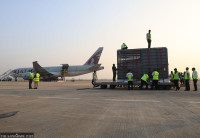Lumbini Province
Jagadishpur Lake drained out, putting wildlife in grave danger
An irrigation office decided to drain the lake to repair a connecting irrigation canal—leaving the wildlife in the area to fight for their survival
Manoj Paudel
Jagadishpur Lake, an artificial lake constructed for the purpose of irrigation, was enlisted in the Ramsar Wetlands Site on August 2003. The lake is spread over an area of 157 hectares and lies 11km north of Taulihawa, the district headquarters of Kapilvastu.
Over the years, many species of reptiles, mammals and fishes among other wildlife have come to depend on the lake for sustenance. The lake is known to support 43 fish species, and they now face the danger of being wiped out. A month ago, the Badganga Irrigation Division Office decided to drain the lake to repair a connecting irrigation canal—leaving the wildlife in the area to fight for their survival.
The western part of the lake has only 10 percent of water at present. The locals have also started to fish on the lake, killing at least 10 to 12 quintals of fishes daily.
Ram Krishna Ghorasaine, chief of the irrigation division office, said, “Our priority is to supply water to the farmlands, and the irrigation canal is in need of repair. We aren’t concerned about birds and other wildlife.”
Abdul Rasid Khan, a local, said that the concerned stakeholders have been turning a blind eye to the destruction of wildlife in and around the lake.
Endangered fishing cats, tortoises, salamanders and birds are at risk after the lake dried up. According to conservationists, of the 872 species of birds found in Nepal, more than 164—including grebes, cormorants, herons, egrets, stork, ducks and geese, terns and gulls—are found in the lake.
Birds migrate from Siberia, China, Russia, Mongolia, Turkmenistan and Kyrgyzstan to the area with the start of the winter season and remain there until February.
Ornithologist Hem Sagar Baral said that endangered species who depend on the lake for survival are at grave danger.
“Some bird species are currently in the middle of reproduction activities. The survival of the many species is at stake now,” Baral said.




 8.12°C Kathmandu
8.12°C Kathmandu










%20(1).jpg&w=300&height=200)

